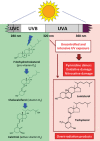Vitamin D status and risk for malignant cutaneous melanoma: recent advances
- PMID: 28125434
- PMCID: PMC5627529
- DOI: 10.1097/CEJ.0000000000000334
Vitamin D status and risk for malignant cutaneous melanoma: recent advances
Abstract
Cutaneous malignant melanoma, whose incidence is increasing steadily worldwide, is the result of complex interactions between individual genetic factors and environmental risk factors. Ultraviolet radiation represents the most important environmental risk factor for the development of skin cancers, including melanoma. Sun exposure and early sunburn during childhood are the principal causes of cutaneous melanoma insurgence in adults, with double the risk relative to a nonexposed population. Consequently, ultraviolet protection has long been recognized as an important measure to prevent such a malignancy. Biological and epidemiological data suggest that vitamin D status could affect the risk of cancer and play a role in cancer prevention by exerting antiproliferative effects. Solar radiations are critical for vitamin D synthesis in humans; however, uncontrolled and intensive sun exposure is dangerous to skin health and may contribute toward the development of cutaneous malignant melanoma. An optimum balance between sun protection and exposure is thus advocated. Additional research is required to confirm the preventive role of vitamin D in melanoma incidence or a positive influence on patient outcome.
Figures
References
-
- Bonilla C, Boxill LA, Donald SA, Williams T, Sylvester N, Parra EJ, et al. (2005). The 8818 G allele of the agouti signaling protein (ASIP) gene is ancestral and is associated with darker skin color in African Americans. Hum Genet 116:402–406. - PubMed
-
- Colombino M, Lissia A, Franco R, Botti G, Ascierto PA, Manca A, et al. (2013). Unexpected distribution of cKIT and BRAF mutations among southern Italian patients with sinonasal melanoma. Dermatology 226:279–284. - PubMed
Publication types
MeSH terms
Substances
LinkOut - more resources
Full Text Sources
Other Literature Sources
Medical




